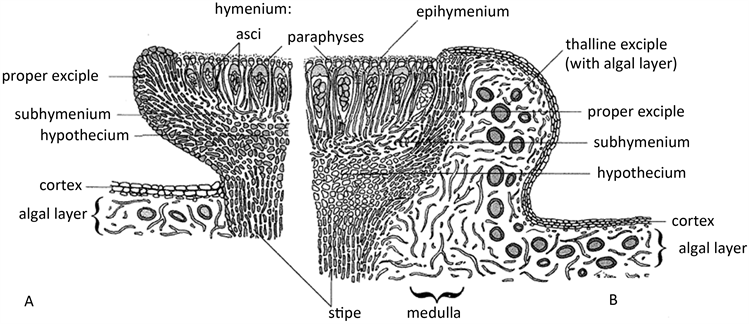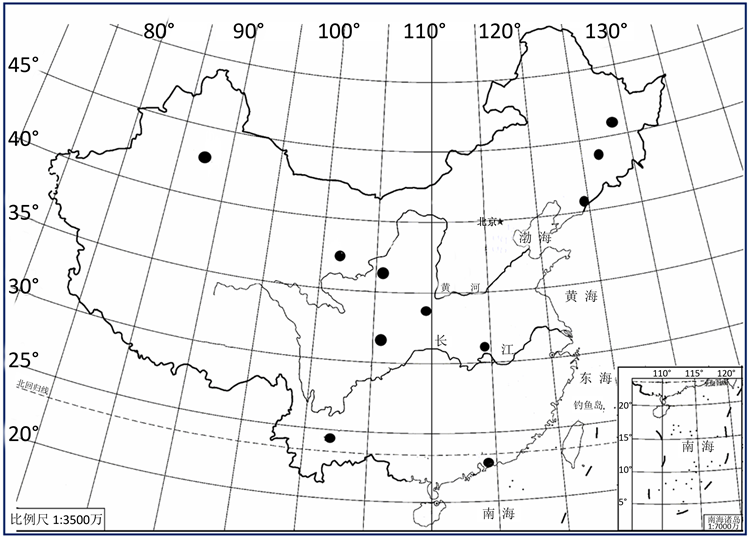Botanical Research
Vol.07 No.02(2018), Article ID:23982,8
pages
10.12677/BR.2018.72013
The Research Progress of the Genus Lecidea and Identification of Some Lecidea, Lecidella and Porpidia Species in Many Areas
Aerguli Jamahate, Abudulla Abbas*
College of Life Science and Technology, Xinjiang University, Urumqi Xinjiang

Received: Feb. 19th, 2018; accepted: Mar. 2nd, 2018; published: Mar. 9th, 2018

ABSTRACT
The genus Lecidea belongs to Lecideaceae, which is the typical genus of Lecideaceae, including approximately 100 species in the genus. In China, systematic studies have been barely done on Lecidea, and 40 species and 1 variation species have been reported. Because of the wide distributions of the genus Lecidea, its morphological structures have variations. Other crustose lichens that are superficially similar with a hand lens include species of Lecidella and Porpidia. In the paper, a preliminary study on morphology and chemical components was conducted between the three genera. Meanwhile, with the help of molecular phylogeny methods, the phylogenetic relationship about the genera were studied. The phylogeny of Lecidea, Lecidella and Porpidia species was studied, based on ITS sequences using ML analyses. Phylogenetic relationships among 17 individuals representing 7 Lecidea species, 5 Lecidella species and 5 Porpidia species, mainly from different countries around the world, were included in the analyses. Our phylogenetic analyses supported traditional genera delimitations based on morphological and chemical traits in most but not all cases.
Keywords:Lecideaceae, Lecidea, Advance, Lecidella, Porpidia
网衣属研究进展及其相关属之间的辨别
阿尔古丽·加玛哈特,阿不都拉·阿巴斯*
新疆大学,生命科学与技术学院,新疆 乌鲁木齐

收稿日期:2018年2月19日;录用日期:2018年3月2日;发布日期:2018年3月9日

摘 要
网衣属隶属于网衣科,是网衣科的模式属,目前已知种有100多种,而国内对于网衣属系统研究较少,国内已报道的网衣属(Lecidea Ach.)为40种,1变种。由于该属分布广泛,使得该属在形态结构上变异程度较大,在其形态上与假网衣属(Porpidia Körb.)和小网衣属(Lecidella Körb.)极为相似,本文中初步探究三个属形态学及化学成分存在的差异,同时借助分子系统学研究手段,解决属之间进化距离关系。本论文选取NCBI数据库中分布于不同地区的Lecidea属7个种、Lecidella属5个种和Porpidia属5个种的ITS基因序列,利用最大似然法(ML)构建该三个属之间的系统发育关系。系统发育关系所显示的结果与传统形态学分类方法基本一致。
关键词 :网衣科,网衣属,研究进展,小网衣属,假网衣属

Copyright © 2018 by authors and Hans Publishers Inc.
This work is licensed under the Creative Commons Attribution International License (CC BY).
http://creativecommons.org/licenses/by/4.0/


1. 网衣属及其相关属的研究概况
网衣属代表了网衣型子囊盘类型,代表地衣演化的一个重要方向。网衣属地衣的研究可追溯到1803年Acharius建立了网衣属(Lecidea)。1826年Chevalier建立了网衣科,将该科分为Lecanora、Lecidea和Rhizocarpon三个属,将Lecidea定为该科的模式属 [1] 。19世纪30年代后显微技术在地衣分类学中的广泛应用,1926年Zahlbruckner将当时包含1200多个种的Lecidea属中许多种划分出来,进一步缩小了网衣属的范畴 [2] 。1984年Hafellner通过研究网衣科以及茶渍科地衣子囊顶器,保留了Lecidea属仅具有Lecidea-type子囊顶器的种,并将具有其他类型子囊顶器网衣属地衣移出该属 [3] 。Hertel于1995、2003、2006、2007、2009年先后对欧洲地区网衣属进行系统研究重新界定了对网衣属范畴,即子囊盘为黑色网衣型,子囊顶器为Lecidea-type,孢子椭圆形,无色,单胞,无晕圈,主要含有缩酚酸类、缩酚酸环醚类和二苯并呋喃化合物,且几乎全部生长在岩石上的地衣,该范畴的网衣属地衣为狭义的网衣属 [4] [5] [6] [7] [8] 。而将不符合Hertel提出的网衣属定义而又在1926年Zahlbruckner提出的网衣科范畴的一些种类,时至今日又没有被明确分类,暂时置于网衣属范畴称之为广义的网衣属。1989年Rambold对澳洲地区网衣属地衣进行亚属的划即Lecidea、Rehmiopsis和Cladopycnidium,学术界广泛认同该类划分 [9] 。2008年Kirk在真菌学词典中将网衣属定位于子囊菌门、茶渍纲、茶渍亚纲、网衣目、网衣科 [10] 。
随着分子生物学技术的发展,其被广泛应用于地衣分类学中。在形态、地理和化学方法的分类学方法的基础上,结合分子生物学方法,实现了地衣生物多样性研究从宏观结构变化到微观分子结构差异性研究,提高了地衣分类的准确性并揭示了演化规律。2011年Schmull对网衣属22个分类单位进行分子生物学分析,通过研究网衣属地衣uc SSU、nuc LSU、5.8S、mit SSU、RPB1和RPB2的序列,指出1926年Zahlbruckner提出的广义网衣属范畴大多数物种在其他科或目下,而Hertel提出的狭义网衣属的范畴才在网衣科中,进一步证实Hertel界定的网衣属范畴的正确性 [11] 。2014年Fryday通过对网衣属ITS、mt SSU、nuc LSU、RPB1和RPB2序列分析,并结合其形态、解剖和化学特征,将藓抱衣属(Bryobilimbia)从广义的网衣属中划分出来 [12] 。
国外学者对网衣科的研究是系统研究某一地区的网衣属或者在调查某一区域地衣多样性时发现有网衣属地衣进行相关报道。目前较为系统研究区域包括亚洲中、东、南部地区以及欧洲地区的网衣属地衣(Hertel 1967, 1969, 1977, 2006, 2010)。目前,世界范围内网衣属大约100个种。
网衣属国内研究起步较晚,20世纪80年代以前几乎无国内学者对我国境内的地衣网衣科地衣进行鉴定,均是由国外学者报道。1925年Paulson报道了西藏的新记录种1个,即Lecidea auriculata [13] 。1940年Magnusson在研究中亚地衣过程中报道了甘肃省网衣属地衣新种12个 [14] 。1963年Lamb对甘肃和云南境内的网衣属进行研究,报道3个种其中新纪录种1个即Lecidea tessellate [15] 。Lamb于1963年报道了采自中国台湾、甘肃的Lecidea属地衣3种 [15] 。1968年Poelt和Wirth报道了中国甘肃省内Lecidea属地衣1种 [16] 。1979年Schneider报道了云南、甘肃地区的Lecidea属地衣4种 [17] 。1984年Timdal报道了四川省的Lecidea属地衣1种 [17] 。Thower于1988年报道了中国香港Lecidea属地衣1种 [17] 。此后十年间几乎外国学者未对中国境内网衣属进行报道。2002年Aptroot等报道了中国香港地区的Lecidea属地衣1种L. aurigera [18] 。2003年Arocena,Zhu,Hall报道了中国青海省的Lecidea属地衣1种L. plana [19] 。
国内学者对我国境内网衣属的研究追溯到1973年杨王贞容和赖明洲报道了采自中国西藏、四川、台湾等省区Lecidea属地衣4种 [20] 。魏江春与陈健斌在1974年报道了采自珠穆朗玛峰的Lecidea属地衣1种 [17] 。魏江春和姜玉梅分别在1981年和1985年报道了西藏地区的Lecidea属地衣1种L.auriculata [21] 。1982年Hertel与赵丛福报道了吉林省Lecidea属地衣4种 [22] 。1998年阿不都拉·阿巴斯和吴继农在《新疆地衣》一书中记录了新疆地区网衣属地衣3种 [23] 。张璐璐等于2010年和2012年相继报道了采自四川、云南和青海省网衣属地衣新纪录4种 [24] 。截止目前中国境内的已报道网衣属(Lecidea)40种,1变种 [27] 。
2. 网衣属及其相关属区分
网衣属隶属于真菌界(Fungi)、子囊菌门(Ascomycota)、茶渍纲(Lecanoromycetes)、网衣目(Lecideales)、网衣科(Lecideaceae)。该属地衣体通常为壳状少数有鳞片状或者石内生,有白色、灰色、棕色、黄棕色等;通常不具下地衣体,偶有一些种具有下地衣体,一般为黑色、白灰色、蓝黑色色等;子囊盘为网衣型,聚生或散生,直径0.2~3 mm不等,贴生、埋生至半埋生,盘面一般为棕色至黑色,盘缘明显或退化,且盘缘规整、波纹状或龟裂,盘面具或不具粉霜;网衣属已报道的种无附属结构,由于有性繁殖结构子囊盘较发达,因此无性繁殖结构分生孢子器较少见。解剖结构中(图1),髓层一般成灰色,遇碘液变色或不变色;果壳通常碳化,且果壳外部着色深,内部无色或着色较浅;子实层无色,厚度40~150 μm不等;上子实层颜色存在差异,黄色、棕色、橄榄色、墨绿色等;子实下层通常无色,偶有些种有轻微着色;子囊顶器成Lecidea-type,子囊内含8孢子,无色透明,宽椭圆形至长椭圆形,无晕圈;侧丝通常粘合,不分支或顶部略有分支,顶部不膨大或在顶部一个菌丝细胞处略膨大,且该处具着色较深的帽状结构(图2)。据统计网衣属约产生9种类型的次生代谢产物即confluentic acid、norstictic acid、hypostictic acid、gyrophoric acid、planaic acid、2’-O-methylanziaic、2’-O-methylmicrophyllinnic acid、2’-O-methylperlatolic acid、4’-O-demethylplanaic acid [25] 。网衣属是世界广布种,从赤道至两级均有其分布,该属地衣的基物多数为岩石,偶有树皮、苔藓等。
网衣属地衣是地衣类群中鉴定较为困难的属,其在形态结构甚至在化学成分与众多属存在相似性,尤其是茶渍科中的小网衣属(Lecidella)、网衣科中的假网衣属(Porpidia Körber)。Lecidea、Lecidella和Porpidia在形态解剖以及化学成分上存在一些差异。Lecidea和Lecidella二者主要区别在于以下几方面:在分类学上Lecidella主要被定位于真菌界(Fungi)、子囊菌门(Ascomycota)、茶渍纲(Lecanoromycetes)、茶渍目(Lecanorales)、茶渍科(Lecanoceae),该属地衣体通常为灰色且成颗粒状,通常具有黑色、蓝黑色或者白灰色的下地衣体;具粉芽、粉芽堆及裂芽等营养繁殖结构;通常具有无性繁殖结构分生孢子器;子囊呈

Figure 1. The structures of apothecia A: The structure of lecideine apothecia; B: The structure of lecanorine apothecia [28]
图1. 子囊盘结构;A:网衣型子囊盘结构;B:茶渍型子囊盘结构 [28]

Figure 2. The types of asci; A: The Lecidea-type asci; B: The Porpidia-type asci ; C: The Lecanora-type asci [28]
图2. 子囊顶器的类型;A:网衣型子囊顶器;B:假网衣型子囊顶器;C:茶渍型子囊顶器 [28]
Lecanore-type;侧丝大多数不粘合,易分散;次生代谢产物一般为杂环蒽酮类(Xanthones)、缩酚酸环醚类(orcinol depsidones)、对位缩酚酸类(β-orcinol depsides)、三萜烯化合物(triterpenoids) [26] 。Lecidea同Porpidia二者均属于网衣科,但是Porpidia具粉芽、粉芽堆及裂芽等营养繁殖结构;通常具有无性繁殖结构分生孢子器;子囊顶器呈Porpidia-type (图2);子囊孢子具晕圈;侧丝粘合且分支;次生代谢产物一般为confluentic acid、norstictic acid、hypostictic acid、2’-O-methylmicrophyllinnic acid、2’-O-methylperlatolic acid [27] 。由于这三个属之间形态差异极不明显,仅凭形态和化学成分区分和鉴定三个属地衣困难较大。因此通过对Lecidea、Lecidella和Porpidia的ITS序列构建进化树来分析三个属之间存在的关系,从而加深。
3. 系统发育树的构建
用于构建进化树的Lecidea、Lecidella和Porpidia的共17条序列均选自NCBI数据库,所用序列的种名、产地以及GeneBank序列号在表1所示。利用MEGA7.0中的ClustalW方法进行多序列比对,然后对序列进行手工校正,保留18S和28S的部分序列以及完整的ITS1、5.8S和ITS2的序列。再利用MEGA7.0软件按邻接法(NJ)构建系统发育树,其中自展检测值(Bootstrap)设置为1000,进化距离采用方法为Minimum Evolution (ME)、Maximum Composite Likelihood (ML)、Neighbour Joining (NJ)、Maksimum Parsimony (MP)、UPGMA等方法 [29] [30] [31] [32] 。利用MP、ML、NJ和UPGMA方法的构建进化树之间并无较大的差异,因此本文中只展示了最大似然法(ML)构建的进化树(见图3)。
Table 1. The information about the sequences in the study
表1. 本文所用的序列信息表

Figure 3. Phylogenetic tree of Lecidea, Lecidella and Porpidia basing on ITS data of partial spcies (ML method)
图3. 网衣属、小网衣属和假网衣属部分种的ITS序列系统发育树(ML)

Figure 4. The current distributions of the genus Lecidea in China
图4. 目前网衣属在中国境内分布状况
Lecidea、Lecidella和Porpidia在形态学和解剖学特征上十分相似,极易混淆,但Lecidea和Porpidia具有的次生代谢产物具有相似性,二者均有confluentic acid、norstictic acid、hypostictic acid、2’-O-methylmicrophyllinnic acid、2’-O-methylperlatolic acid,在ML系统发育树中(见图3),Lecidea和Porpidia二者进化距离较近,Lecidea与Lecidea进化距离最远,与形态解剖特征以及分类学地位的结果一致,Lecidea和Porpidia隶属于网衣科,Lecidella属于茶渍科。Lecidea、Lecidella和Porpidia其他种的分子数据尚缺乏或不完整,因此该三个属的系统发育有待进一步研究。
4. 中国境内网衣属目前已知的分布状况
根据相关的文献,目前已报道的网衣属在中国分布状况如下:甘肃省、黑龙江省、吉林省、辽宁省、青海省、陕西省、台湾、新疆自治区、西藏自治区、香港、云南省共7个省、2个自治区、1个特别行政区以及1个岛(见图4)。由此可知网衣属在中国的境内具有广泛的分布,从干旱寒冷的新疆到温热多雨的云南均有其分布,由此可知网衣属具有极强的环境适应性,能够适应不同的气候条件,具有较广的生态幅度。
5. 结论
网衣科作为地衣类型中重要组成,代表了网衣型地衣重要演化过程。网衣属为网衣科的模式属,展现了该科的重要的特征。对网衣属的范畴历来就存在众多的争议,包括广义的网衣属和狭义的网衣属。本研究主要针对狭义的网衣属进行了研究,通过研究总结出国内外研究学者对网衣属的研究概况,并对网衣属同小网衣属、假网衣属之间进行形态学及化学成分进行比较,继而在其基础上对3个属一些种构建了系统发育树,得出通过形态及化学成分对网衣属、小网衣属及假网衣属的区分及分类地位确定是可靠地。
基金项目
国家自然科学基金项目(31670023)。
参考文献
[1] Chevallier, F.F. (1827) Flore Générale des Environs de Paris. Selon la Méthode Naturelle, 20, 286.
[2] Zahlbruckner, A. (1926) Lichens. In: Engler & Prantl, Die Natürlichen Pflanzenfamilien 2. Aufl, 61-270, Leipzig.
[3] Hafellner, J. (1984) Studien in Richtung einer naturlicheren Gliederung der Sammelfamilien Lecanoraceae und Lecideaceae. Beiheft zur Nova Hedwigia, 241-371.
[4] Hertel, H. (1995) Schlüssel für die Arten der Flechtenfamilie Lecideaceae in Europa. In: Farkas, E.E., Lücking, R. and Wirth, V., Eds., Scripta Lichenologica Lichenological Papers Dedicated to Antonín Vezda, Beih. Nova Hedwigia, 58, 137-180.
[5] Hertel, H. and Adreev, M.P. (2003) On Some Saxicolous Lecideoid Lichens of the Beringian Region and Adjacent Areas of Eastern Siberia and the Russian Far East. The Bryologist, 106, 539-551. https://doi.org/10.1639/0007-2745(2003)106[539:OSSLLO]2.0.CO;2
[6] Hertel, H. (2006) World Distribution of Species of Lecidea (Lecanorales) Occurring in Central Europe. In: Lackovicova, A., Guttova, A., Lisicka, E. and Lizon, P., Eds., Central European Lichens Diversity and Threat, Mycotaxon, Ltd., Ithaca.
[7] Hertel, H. (2007) Notes on and Records of Southern Hemisphere Lecideoid Lichens. Bibliotheca Lichenologica, 95, 267-296.
[8] Hertel, H. (2009) A New Key to Cryptothalline Species of the Genus Lecidea (Lecanorales). In: Aptroot, A., Seaward, M.R.D. and Sparrius, L.B., Eds., Biodiversity and Ecology of Lichens. Liber Amicorum Harrie Sipman. Bibliotheca Lichenologica 99. J. Cramer in der Gebrüder Borntraeger Verlagsbuchhandlung, Berlin-Stuttgart, 185-204.
[9] Rambold, G. (1989) A Monograph of the Saxicolous Lecideoid Lichens of Australia (excl. Tasmania). Bibliotheca Lichenologica, 34, 1-345.
[10] Kirk, P.M., et al. (2008) Dictionary of the Fungi. 10th Edition. CABI Bioscience: CAB International, 366.
[11] Schmull, et al. (2011) Phylogenetic Affiliations of Members of the Heterogeneous Lichen-Forming Fungi of the Genus Lecidea Sensu Zahlbruckner (Lecanoromycetes, Ascomycota). Mycologia, 103, 983-1003. https://doi.org/10.3852/10-234
[12] Fryday, A.M., Printzen, C. and Ekman, S. (2014) Bryobilimbia, a New Generic Name for Lecidea Hypnorum and closely Related Species. Lichenologist, 46, 25-37. https://doi.org/10.1017/S0024282913000625
[13] Paulson, R. (1925) Lichens of Mount Everest. Journal of Experimental Botany, 63, 189-193.
[14] Magnusson, A.H. (1940) Lichens from Central Asia I. Rep. Sci. Exped. N.W. China S. Hedin—The Sino-Swedish Expedition (Publ.13). XI Bot, 1, 85-133.
[15] Lamb, I.M. (1963) Index Nominum Lichenum inter annos 1932 et 1960 divulgatorum. New York, 1-809.
[16] Wirth, V. and Poelt, J. (1964) Flechten aus dem nordostlichen Afghanistan, gesammelt von H. Roemer im Rahmen der Deutschen Wakhan-Expedition. Mitteilungen der Botanischen Staatssammlung München, 7, 219-261.
[17] 史秀莉, 杨芳, 赵遵田. 网衣属(Lecidea)地衣的研究进展[J]. 安徽农学通报, 2007(23): 46-153.
[18] Aptroot, A. (2002) Corticolous and Saxicolous Lichens from Xishuangbanna, Southern Yunnan, China.
[19] Aptroot, A. and Sparrius, L.B. (2003) New Microlichens from Taiwan. Fungal Diversity, 14, 1-50.
[20] Wang-Yang, J.R. and Lai, M.J. (1973) A Checklist of the Lichens of Taiwan. Taiwania, 18, 83-104.
[21] Chen, J.B., Wu, J.N. and Wei, J.C. (1989) Lichens of Shennongjia in Fungi and Lichens of Shennongjia. World Publishing Corp., Beijing, 386-493.
[22] Hertel, H. and Zhao, C.F. (1982) Lichens from Changbai Shan—Some Additions to the Lichen Flora of Northeast China. Lichenologist, 14, 139-152. https://doi.org/10.1017/S0024282982000280
[23] Abdulla, A. and Wu, J.N. (1998) Lichens of Xinjiang. Sci-Tech & Hygiene Publishing House of Xinjiang (K), Urumqi.
[24] 张璐璐. 中国西部地区网衣及其相关属地衣的初步研究[D]: [博士学位论文]. 济南: 山东师范大学, 2012.
[25] 胡玲. 中国网衣科(Lecideaceae)地衣的分类学研究[D]: [博士学位论文]. 济南: 山东师范大学, 2015.
[26] 赵欣. 中国小网衣属(Lecidella)及其相关属地衣的系统分类学研究[D]: [博士学位论文]. 济南: 山东师范大学, 2016.
[27] 赵祥祥. 中国假网衣属(Porpidia)地衣的分类学研究[D]: [博士学位论文]. 济南: 山东师范大学, 2017.
[28] Olday, F. (2008) Lichen Flora of the Greater Sonoran Desert Region, Volume I: The Pyrenolichens and Most of the Squamulose and Macrolichens/Lichen Flora of the Greater Sonoran Desert Region, Volume 2: Most of the Microlichens, Balance of the Macrolichens. Northeastern Naturalist, 15, 314.
[29] Sudhir, K., Glen, S. and Koichiro, T. (2016) MEGA7: Molecular Evolutionary Genetics Analysis Version 7.0 for Bigger Datasets. Molecular Biology and Evolution, 33, 1870-1874. https://doi.org/10.1093/molbev/msw054
[30] Zhang, W. and Sun, Z.R. (2008) Random Local Neighbor Joining: A New Method for Reconstructing Phylogenetic Trees. Molecular Phylogenetics and Evolution, 47, 117-128. https://doi.org/10.1016/j.ympev.2008.01.019
[31] Felsenstein (1985) Confidence Limits on Phylogenies: An Approach Using the Bootstrap. Evolution, 39, 783-791. https://doi.org/10.1111/j.1558-5646.1985.tb00420.x
[32] Tamura, K., Nei, M. and Kumar, S. (2004) Prospects for Inferring Very Large Phylogenies by using the Neighbor-Joining Method. Proceedings of the National Academy of Sciences, 101, 11030-11035. https://doi.org/10.1073/pnas.0404206101
知网检索的两种方式:
1. 打开知网页面http://kns.cnki.net/kns/brief/result.aspx?dbPrefix=WWJD
下拉列表框选择:[ISSN],输入期刊ISSN:2164-540X,即可查询
2. 打开知网首页http://cnki.net/
左侧“国际文献总库”进入,输入文章标题,即可查询
投稿请点击:http://www.hanspub.org/Submission.aspx
期刊邮箱:br@hanspub.org
